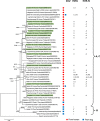Genomic studies on Strongyloides stercoralis in northern and western Thailand
- PMID: 32404172
- PMCID: PMC7222524
- DOI: 10.1186/s13071-020-04115-0
Genomic studies on Strongyloides stercoralis in northern and western Thailand
Abstract
Background: Strongyloidiasis is a soil borne helminthiasis, which in most cases is caused by Strongyloides stercoralis. Human infections with S. fuelleborni fuelleborni and S. fuelleborni kellyi also occur. Although up to 370 million people are currently estimated to be infected with S. stercoralis, this parasite is frequently overlooked. Strongyloides stercoralis is prevalent among humans in Thailand; however, S. fuelleborni fuelleborni has also been reported. Three recent genomic studies of individual S. stercoralis worms found genetically diverse populations of S. stercoralis, with comparably low heterozygosity in Cambodia and Myanmar, and less diverse populations with high heterozygosity in Japan and southern China that presumably reproduce asexually.
Methods: We isolated individual Strongyloides spp. from different localities in northern and western Thailand and determined their nuclear small ribosomal subunit rDNA (18S rDNA, SSU), in particular the hypervariable regions I and IV (HVR-I and HVR-IV), mitochondrial cytochrome c oxidase subunit 1 (cox1) and for a subset whole genome sequences. These sequences were then compared with each other and with published sequences from different geographical locations.
Results: All 237 worms isolated from 16 different human hosts were S. stercoralis, no S. fuelleborni was found. All worms had the common S. stercoralis SSU HVR IV haplotype A. Two different SSU HVR I haplotypes (I and II), both previously described in S. stercoralis, were found. No animal heterozygous for the two haplotypes was identified. Among the twelve cox1 haplotypes found, five had not been previously described. Based upon the mitochondrial cox1 and the nuclear whole genome sequences, S. stercoralis in Thailand was phylogenetically intermixed with the samples from other Southeast Asian countries and did not form its own branch. The genomic heterozygosity was even slightly lower than in the samples from the neighboring countries.
Conclusions: In our sample from humans, all Strongyloides spp. were S. stercoralis. The S. stercoralis from northern and western Thailand appear to be part of a diverse, intermixing continental Southeast Asian population. No obvious indication for genetic sub-structuring of S. stercoralis within Thailand or within the Southeast Asian peninsula was detected.
Keywords: Neglected tropical disease; Phylogeny; SSU; Strongyloides stercoralis; Strongyloidiasis; cox1.
Conflict of interest statement
The authors declare that they have no competing interests.
Figures



Similar articles
-
Strongyloides stercoralis genotyping in a human population in southwestern Iran.Parasit Vectors. 2024 Jan 16;17(1):21. doi: 10.1186/s13071-023-06103-6. Parasit Vectors. 2024. PMID: 38229164 Free PMC article.
-
Possible transmission of Strongyloides fuelleborni between working Southern pig-tailed macaques (Macaca nemestrina) and their owners in Southern Thailand: Molecular identification and diversity.Infect Genet Evol. 2020 Nov;85:104516. doi: 10.1016/j.meegid.2020.104516. Epub 2020 Aug 27. Infect Genet Evol. 2020. PMID: 32860989
-
First molecular identification and genetic diversity of Strongyloides stercoralis and Strongyloides fuelleborni in human communities having contact with long-tailed macaques in Thailand.Parasitol Res. 2017 Jul;116(7):1917-1923. doi: 10.1007/s00436-017-5469-z. Epub 2017 May 12. Parasitol Res. 2017. PMID: 28500375
-
Strongyloides genotyping: a review of methods and application in public health and population genetics.Int J Parasitol. 2021 Dec;51(13-14):1153-1166. doi: 10.1016/j.ijpara.2021.10.001. Epub 2021 Oct 30. Int J Parasitol. 2021. PMID: 34757088 Review.
-
Assessment of the global paradigms of genetic variability in Strongyloides stercoralis infrapopulations determined by mitochondrial DNA sequences.Comp Immunol Microbiol Infect Dis. 2019 Dec;67:101354. doi: 10.1016/j.cimid.2019.101354. Epub 2019 Sep 26. Comp Immunol Microbiol Infect Dis. 2019. PMID: 31586852 Review.
Cited by
-
Human strongyloidiasis: complexities and pathways forward.Clin Microbiol Rev. 2023 Dec 20;36(4):e0003323. doi: 10.1128/cmr.00033-23. Epub 2023 Nov 8. Clin Microbiol Rev. 2023. PMID: 37937980 Free PMC article. Review.
-
Insights into Infant Strongyloidiasis, Papua New Guinea.Emerg Infect Dis. 2025 Sep;31(9):1793-1801. doi: 10.3201/eid3109.241923. Emerg Infect Dis. 2025. PMID: 40867023 Free PMC article.
-
Terrestrial invertebrate hosts of human pathogens in urban ecosystems.Eco Environ Health. 2024 Apr 16;3(3):369-380. doi: 10.1016/j.eehl.2024.04.003. eCollection 2024 Sep. Eco Environ Health. 2024. PMID: 39281069 Free PMC article. Review.
-
From past to present: opportunities and trends in the molecular detection and diagnosis of Strongyloides stercoralis.Parasit Vectors. 2023 Apr 11;16(1):123. doi: 10.1186/s13071-023-05763-8. Parasit Vectors. 2023. PMID: 37041645 Free PMC article. Review.
-
Strongyloides stercoralis genotyping in a human population in southwestern Iran.Parasit Vectors. 2024 Jan 16;17(1):21. doi: 10.1186/s13071-023-06103-6. Parasit Vectors. 2024. PMID: 38229164 Free PMC article.
References
MeSH terms
Substances
Grants and funding
LinkOut - more resources
Full Text Sources
Miscellaneous

